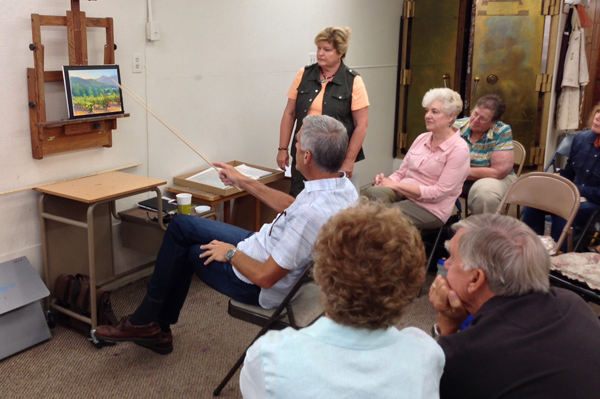The act of painting can be a solitary endeavor. The majority of an artist’s studio time is spent in contemplative interaction between subject matter and surface. Even when surrounded by fellow artists, either in a classroom or plein air event, it’s as if we are alone. England’s venerable statesman, Sir Winston Churchill, summed it up this way, “Painting is complete as a distraction. I know of nothing, which without exhausting the body, more entirely absorbs the mind.”
While a passion to communicate visually lies at the core of the desire to paint, and the diversity of individual vision ultimately leads to great artistic expression, artwork cannot be created in a vacuum. The feedback, both positive and negative, garnered from others plays its part in our creative development. Having perspective on what we are asking for and what we are receiving is the key to making critical feedback useful.

A candid shot during critique day, offered in my weekly masters class.
The intimacy involved in painting can make it hard to be subjective. Heartfelt emotions are involved and often cloud objectivity. This leads many painters to seek the viewpoints of peers whether from formal group critiques or individual one-on-one assessment. The definition of critique varies from a detailed analysis and assessment, to careful judgment in which opinion about what is good and bad are voiced. Having been both the agent and recipient of innumerable critiques, I have a few observations that may prove helpful when receiving feedback:
- Spend time contemplating what you really hope to gain from the critique. This is where personal introspection will be useful. Most of us try very hard. We put the total sum of our abilities into every painting. What we often hope for is more of a validation of those efforts than a brutal, sometimes seemingly callous evaluation of what is technically wrong.
- Know what you like about your painting before asking for criticism. The better you know what it is you like or dislike before receiving criticism, the better able you will be to put it into perspective. Listen to what is said, make sure it applies, and then ask yourself: Do I think it would be better changed or do I like it just the way it is? Remember; it doesn’t have to become an argument to win the critic over to your side. It is just their opinion.
- Seek peers whenever possible. The more respect you have for the critic, the easier it is to accept. Evaluate the critic by studying his or her works. Attempt to understand his or her biases. We all have them. Some of us are technical absolutists and others celebrate the breaking of rules.
- Don’t discredit positive feedback. It is often easier for us to accept negative criticism. When I praise a student, they frequently respond, “Well, I didn’t know what I was doing and I couldn’t do it again.” When a negative comment is given they respond with, “I knew I didn’t know what I was doing. I am so stupid.”
A little introspection and understanding of what you hope to gain from exposing yourself to criticism is the key to making is useful. A little introspection can go a long way in avoiding the dreaded critique question: Do I look fat in these jeans?
Photo courtesy of Janie Hutchinson.
MORE RESOURCES FOR ARTISTS

• NEW! Successful Pastel Portraits with Alain Picard Value Pack is on sale now!
• Subscribe to Pastel Journal magazine
• Watch pastel art workshops on demand at ArtistsNetwork.TV
• Get unlimited access to over 100 art instruction ebooks.
SOURCE: Artist’s Network – Read entire story here.